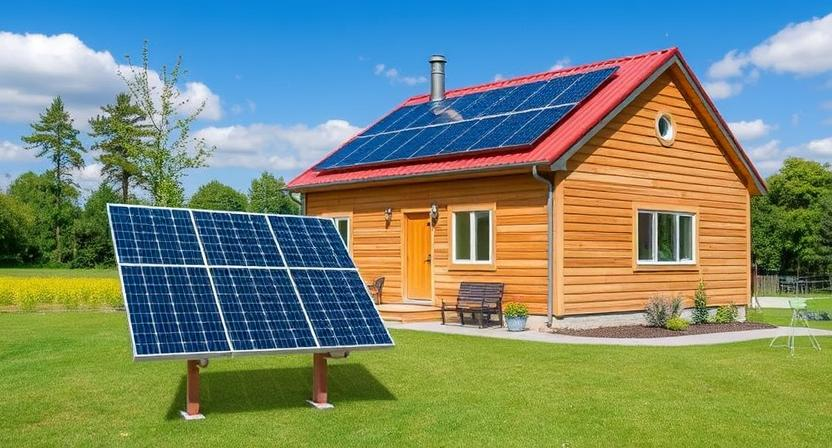Types of Solar Power Systems

When it comes to solar power systems, there are primarily two main types: grid-tied systems and off-grid systems. Grid-tied systems are connected to the main power grid and often use net metering to allow excess energy generated to be sold back to the utility company. These systems are popular for their ability to save on electricity bills and for their ease of installation and maintenance.
On the other hand, off-grid systems operate independently of the main power grid and require batteries to store excess energy for use when sunlight is not available. Off-grid systems are commonly used in remote areas where connecting to the grid is not feasible or cost-effective. While they provide energy independence, they require careful planning and monitoring to ensure a reliable power supply.
Understanding Solar Energy
Solar energy is a renewable source of power derived from the sun’s radiation. This energy can be harnessed using photovoltaic cells, commonly known as solar panels, which convert sunlight into electricity. The process involves capturing the sun’s energy through these panels and converting it into usable electricity, providing a sustainable alternative to traditional fossil fuels.
Understanding solar energy involves recognizing its potential to reduce carbon emissions and decrease reliance on non-renewable resources. By harnessing the power of the sun, individuals and communities can generate their electricity in an environmentally friendly manner. Solar energy offers a clean and sustainable solution to meeting energy needs while contributing to a greener and more sustainable future.
Factors to Consider Before Going Off the Grid
When considering the shift to an off-grid solar power system, it is essential to evaluate your energy needs accurately. Understanding your electricity consumption patterns will help determine the size and capacity of the solar power system required to meet your household’s demands. Assess the appliances and devices that will be powered by the solar energy system to ensure it can sustain your daily usage without interruptions. Additionally, consider any future expansions or changes in energy usage that may affect the system’s capacity.
Another crucial factor to contemplate before going off the grid is the availability of sunlight in your location. Solar power systems rely on sunlight to generate electricity, so it is vital to ensure your area receives an adequate amount of sunlight throughout the year. Factors such as shading from trees or nearby buildings can impact the efficiency of your solar panels, affecting their ability to harness solar energy effectively. Conducting a solar site analysis to determine the best placement for your panels can optimize their performance and maximize your energy production.
Benefits of Using Solar Power
Harnessing solar power offers numerous benefits to both homeowners and the environment. One of the primary advantages is the potential for substantial cost savings on electricity bills. By generating your own electricity from the sun, you can reduce or even eliminate your reliance on traditional utility providers, resulting in long-term financial benefits.
Another key benefit of solar power is its positive impact on the environment. Solar energy is a clean and renewable source of power that produces no greenhouse gas emissions or harmful byproducts. By choosing to go solar, individuals can significantly reduce their carbon footprint and contribute to a healthier planet for future generations.
Costs Associated with Solar Energy
When considering solar energy for your home or business, it’s important to understand the various costs associated with installation and maintenance. The initial cost of purchasing and installing solar panels can vary depending on factors such as the size of the system, quality of materials, and any additional components required for your specific setup. It’s important to obtain quotes from different solar providers to compare prices and ensure you’re getting the best value for your investment.
In addition to the upfront costs, you should also factor in ongoing expenses such as maintenance and repairs. While solar panels typically require minimal maintenance, it’s important to budget for any unexpected issues that may arise over the lifespan of your system. Regular maintenance, such as cleaning and inspections, can help prolong the life of your solar panels and ensure they continue operating at peak efficiency. Be sure to inquire about warranty options and service packages when selecting a solar provider to help mitigate potential future costs.
How Solar Panels Work

When sunlight hits the solar panels, the photovoltaic cells within the panels absorb the energy from the sun. These cells are made of semiconductor materials that create an electric field across the layers when sunlight is absorbed. This process generates direct current (DC) electricity.
The generated DC electricity then flows through an inverter, where it is converted into alternating current (AC) electricity that can be used to power homes and businesses. The AC electricity is then either used immediately or stored in batteries for later use. This entire process of converting sunlight into electricity is what allows solar panels to provide a renewable and sustainable source of power.
Solar Panel Placement
When considering the placement of solar panels, it is essential to take into account the amount of sunlight the panels will receive throughout the day. Placing panels in an area with maximum sun exposure will ensure optimal energy production. This typically means facing the panels towards the south in the northern hemisphere and towards the north in the southern hemisphere.
Another crucial aspect of solar panel placement is to avoid shading. Even a small amount of shading can significantly impact the performance of solar panels. Therefore, it is important to choose a location that is free from obstructions such as trees, buildings, or other structures that could cast shadows on the panels during peak sunlight hours.
• When considering solar panel placement, ensure maximum sun exposure by facing panels towards the south in the northern hemisphere and towards the north in the southern hemisphere.
• Avoid shading at all costs as even a small amount can significantly impact panel performance.
• Choose a location free from obstructions such as trees, buildings, or other structures that could cast shadows on panels during peak sunlight hours.
Solar Panel Maintenance
Regular maintenance of solar panels is essential to ensure optimal performance and longevity. One important aspect of maintenance is keeping the panels clean from dust, dirt, and debris that can accumulate over time. Regularly washing the panels with water and a mild detergent can help maximize sunlight absorption and energy production.
In addition to cleaning, it is important to periodically inspect the panels for any signs of damage, such as cracks or corrosion. Any issues should be addressed promptly to prevent further damage and ensure the efficient operation of the system. Checking the wiring and connections for any loose or damaged parts is also crucial to maintaining the overall health of the solar panel system.
Incentives for Using Solar Power
Solar power systems offer a range of incentives for both residential and commercial users. One of the most common incentives is the federal investment tax credit (ITC), which allows eligible entities to deduct a significant portion of their solar system costs from their taxes. Furthermore, many states offer additional tax credits, rebates, and performance-based incentives to encourage the adoption of solar energy.
In addition to financial incentives, some utility companies provide net metering programs, allowing solar system owners to sell excess energy back to the grid for credits on their utility bills. This not only helps offset electricity costs but also promotes a more sustainable and efficient energy grid. Together, these incentives make transitioning to solar power more accessible and cost-effective for individuals and businesses looking to reduce their carbon footprint and energy costs.
Battery Storage Options
When considering solar power systems, it is essential to also think about battery storage options. These systems store excess energy generated by solar panels for use during times when the sun is not shining. By harnessing this stored energy, homeowners can ensure a more continuous and reliable power supply.
Battery storage solutions vary in capacity and technology, providing options for different needs and budgets. Lithium-ion batteries are commonly used for residential applications due to their high efficiency and longevity. Additionally, lead-acid batteries offer a more affordable alternative, though they typically have a shorter lifespan. Understanding the specific requirements of your household and the amount of storage needed is crucial in selecting the right battery storage option for your solar power system.
Grid-Tied vs Off-Grid Systems

Grid-tied systems are connected to the traditional electrical grid, allowing excess energy generated by the solar panels to be fed back into the grid for credits or compensation. This setup means that homeowners have a reliable source of electricity even when solar production is insufficient, drawing power from the grid as needed. On the other hand, off-grid systems operate independently without any connection to the utility grid. Off-grid setups are often preferred in remote locations where grid connection is not feasible or cost-effective, providing complete energy independence but requiring sufficient battery storage for backup power during periods of low sunlight.
Both grid-tied and off-grid systems have their advantages and considerations that homeowners must weigh when deciding which option suits their needs best. Grid-tied systems offer the convenience of being connected to a reliable energy source while also potentially benefitting from net metering policies. In contrast, off-grid systems offer autonomy and self-sustainability but require careful planning to ensure there is adequate energy storage for periods when solar generation is limited. Deciding between these two types of systems ultimately depends on individual energy goals, location, budget, and level of desired independence from the traditional utility grid.
Best Practices for Installing Solar Panels
Installing solar panels requires careful planning and precision to ensure optimal performance and longevity. One crucial best practice is to conduct a thorough site assessment to determine the most suitable location for the panels. Factors such as shading, roof orientation, and structural integrity should be evaluated to maximize sunlight exposure and efficiency. Additionally, choosing high-quality mounting equipment and following manufacturer guidelines during installation is essential to secure the panels properly and avoid any potential damage or safety hazards.
Proper wiring and connection of the solar panels are critical aspects of the installation process. It is imperative to adhere to local electrical codes and regulations to guarantee a safe and compliant system. Moreover, regular maintenance and monitoring of the solar panels are essential to ensure they operate at peak efficiency. Routine inspections for dirt, debris, or damage can help prevent any issues and prolong the lifespan of the solar panel system.
Environmental Impact of Solar Energy
Solar energy is heralded as a clean and renewable source of power that contributes significantly to reducing greenhouse gas emissions. By harnessing sunlight to generate electricity, solar power systems produce minimal air and water pollution compared to traditional fossil fuel sources. The installation and operation of solar panels have a relatively low environmental impact, with the potential to mitigate the adverse effects of climate change.
Furthermore, solar energy helps conserve natural resources and protects ecosystems by decreasing the demand for fossil fuels. The manufacturing process of solar panels does involve energy consumption and potentially harmful chemicals, but the long-term benefits of using solar power outweigh these initial environmental costs. Overall, the widespread adoption of solar energy can play a crucial role in fostering a sustainable and eco-friendly energy landscape.
Common Misconceptions About Solar Power
One common misconception about solar power is that it is only effective in sunny regions. While it’s true that sunlight is needed for solar panels to generate electricity, solar power systems can still work even on cloudy days. The technology has advanced significantly, allowing panels to harness diffused sunlight and produce energy.
Another misconception is that solar panels are extremely expensive to install and maintain. While there is an initial upfront cost, solar power systems can actually save money in the long run by reducing electricity bills. Additionally, many governments offer incentives and rebates to promote the adoption of solar energy, making it a more affordable option for homeowners and businesses alike.
Monitoring Your Solar Power System
Monitoring your solar power system is crucial to ensure optimal performance and efficiency. By regularly checking the output of your solar panels, you can identify any potential issues or malfunctions early on. This proactive approach allows for timely maintenance and repairs, preventing costly damages and maximizing the lifespan of your system.
Additionally, monitoring your solar power system enables you to track your energy production and consumption trends. This information can help you make adjustments to increase your energy savings and overall sustainability. By staying informed about the performance of your solar panels, you can also have peace of mind knowing that your system is operating at its best capacity.
Solar Panel Lifespan

Solar panel lifespan is a crucial consideration for those investing in solar energy systems. Typically, solar panels are designed to last for 25 to 30 years, ensuring long-term efficiency and cost-effectiveness. However, it’s important to note that the lifespan of solar panels can be influenced by various factors, such as weather conditions, maintenance practices, and the quality of the panels themselves.
Regular maintenance and care can help extend the lifespan of solar panels, ensuring optimal performance over the years. Simple tasks like cleaning the panels regularly, inspecting for any damage, and ensuring proper installation can all contribute to maximizing the longevity of your solar energy system. By taking proactive steps to maintain your solar panels, you can ensure that they continue to generate clean and sustainable energy for many years to come.
Choosing the Right Solar Panel Manufacturer
When it comes to choosing the right solar panel manufacturer for your solar power system, there are several key factors to consider. One of the primary considerations is the reputation and experience of the manufacturer. Look for companies that have a proven track record in the industry and have been in business for a considerable amount of time. This can help ensure that the manufacturer is reliable and produces high-quality solar panels that will stand the test of time.
Another important factor to consider when choosing a solar panel manufacturer is the warranty offered on their products. A solid warranty can provide you with peace of mind knowing that your investment is protected. Be sure to carefully read and understand the terms of the warranty, including what is covered and for how long. Additionally, consider the company’s customer service and support options, as having reliable customer service can be crucial if any issues arise with your solar panels in the future.
DIY vs Professional Installation
When it comes to installing solar panels, homeowners often face the decision between tackling the project themselves or hiring professionals. DIY installation can be a cost-effective option for those with the necessary skills and tools. It allows homeowners to have more control over the process and can be a rewarding experience for those who enjoy hands-on projects. However, DIY installation can be time-consuming and may void manufacturer warranties if not done correctly. On the other hand, professional installation provides a hassle-free experience, as experienced installers have the expertise to ensure the system is set up properly and efficiently. While it may come at a higher cost, professional installation can save time and give homeowners peace of mind knowing that their solar panels are installed correctly.
Backup Power Options
When it comes to backup power options for solar power systems, there are a few key choices to consider. One popular option is to utilize a battery storage system, which allows excess energy generated by the solar panels to be stored for use during times when sunlight is not available. This can provide a seamless transition to backup power and ensure that your energy needs are met even when the sun is not shining.
Another backup power option to consider is a generator, which can provide additional power during extended periods of low sunlight or in the event of a system failure. While generators may require fuel and maintenance, they can be a reliable source of backup power when needed. It’s important to assess your energy requirements and the reliability of your solar power system before deciding on the best backup power option for your needs.
Future of Solar Energy Technology
The future of solar energy technology holds great promise, with ongoing advancements in efficiency and affordability. Researchers are focusing on ways to optimize the capture and storage of solar power, making it even more accessible for residential and commercial use. Innovations in materials and design are paving the way for sleeker, more efficient solar panels that can be easily integrated into various structures.
In addition, the integration of artificial intelligence and smart technology into solar energy systems is set to revolutionize the way we harness and utilize solar power. This intersection of renewable energy and cutting-edge technology opens up new possibilities for energy management and grid integration, allowing for a more sustainable and efficient energy infrastructure. As the world shifts towards a greener future, the continuous evolution of solar energy technology will play a crucial role in shaping our energy landscape for years to come.




